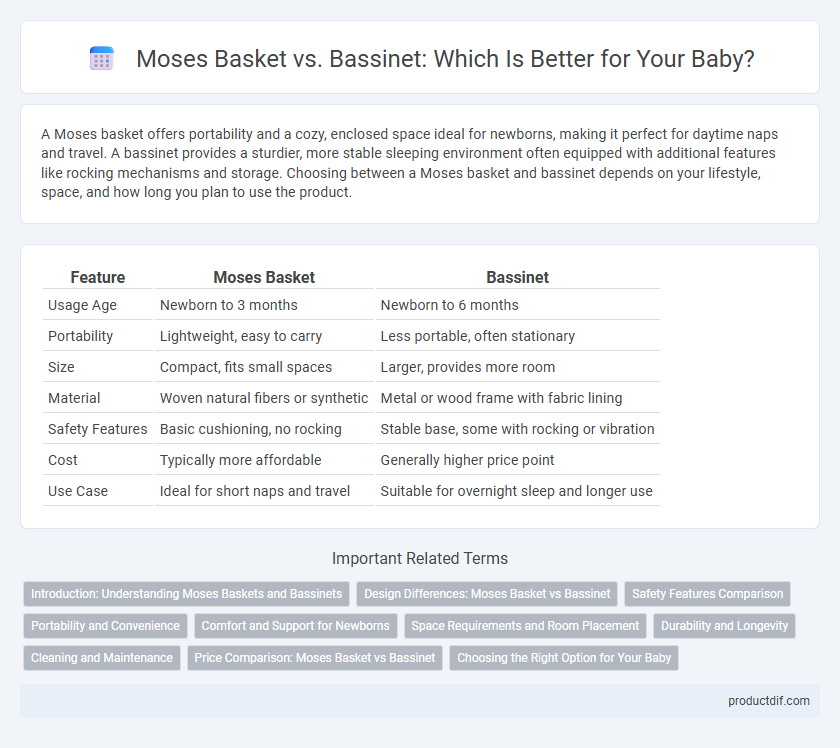A Moses basket offers portability and a cozy, enclosed space ideal for newborns, making it perfect for daytime naps and travel. A bassinet provides a sturdier, more stable sleeping environment often equipped with additional features like rocking mechanisms and storage. Choosing between a Moses basket and bassinet depends on your lifestyle, space, and how long you plan to use the product.
Table of Comparison
| Feature | Moses Basket | Bassinet |
|---|---|---|
| Usage Age | Newborn to 3 months | Newborn to 6 months |
| Portability | Lightweight, easy to carry | Less portable, often stationary |
| Size | Compact, fits small spaces | Larger, provides more room |
| Material | Woven natural fibers or synthetic | Metal or wood frame with fabric lining |
| Safety Features | Basic cushioning, no rocking | Stable base, some with rocking or vibration |
| Cost | Typically more affordable | Generally higher price point |
| Use Case | Ideal for short naps and travel | Suitable for overnight sleep and longer use |
Introduction: Understanding Moses Baskets and Bassinets
Moses baskets are lightweight, portable sleeping solutions made from woven materials, ideal for newborns during the first few months. Bassinets offer a sturdier structure with mesh sides and often include features like rocking or storage, providing a safe and comfortable sleep environment. Both options prioritize infant safety and convenience, but their design and functionality cater to different parental needs.
Design Differences: Moses Basket vs Bassinet
Moses baskets feature a lightweight, portable, and woven design with handles, making them ideal for easy transportation and short-term use. Bassinets typically offer a sturdier frame with a breathable mesh or solid sides, designed for stationary placement and longer sleep durations. The design differences influence airflow, safety standards, and convenience, with bassinets often including additional features like adjustable height and storage compartments.
Safety Features Comparison
Moses baskets feature breathable sides made from natural materials like palm or wicker, allowing for improved air circulation to reduce the risk of overheating, while bassinets often include mesh panels designed for enhanced airflow and visibility. Both products typically meet safety standards such as JPMA certification, but bassinets frequently provide sturdier frames with locking mechanisms to prevent tipping, offering added stability. The choice between the two hinges on balancing portability and structure, with safety prioritized through firm mattresses and secure strap systems in both options.
Portability and Convenience
Moses baskets are lightweight and compact, making them highly portable and ideal for moving between rooms or traveling. Bassinets, although slightly bulkier, often include features like wheels or adjustable height, enhancing convenience within the home. Both options prioritize easy access to the baby, but Moses baskets excel in effortless portability for on-the-go parents.
Comfort and Support for Newborns
Moses baskets and bassinets both offer essential comfort and support tailored for newborns, with Moses baskets providing a cozy, portable sleeping space made from breathable materials that help regulate baby's temperature. Bassinets typically feature sturdier frames and thicker padding, ensuring enhanced support and stability for infants during their early months. Choosing between them depends on parental preference for portability versus structural support, but both prioritize ergonomic designs that promote healthy sleep posture for newborns.
Space Requirements and Room Placement
Moses baskets are compact and lightweight, making them ideal for small spaces and easy to move between rooms, requiring minimal floor area often around 18x30 inches. Bassinets tend to be larger with built-in storage or features, typically needing more space, approximately 25x35 inches, and are designed for stationary placement in nurseries or bedrooms. Choosing between the two depends on available room space, where Moses baskets suit tight or multi-room living, while bassinets fit better in dedicated nursery settings.
Durability and Longevity
Moses baskets are typically crafted from woven natural materials like palm or wicker, offering lightweight portability but less durability over time compared to bassinets. Bassinets often feature more robust frames made from wood or metal, providing enhanced longevity and the ability to support growing infants safely. Choosing a bassinet ensures extended use through the early months due to its sturdy construction and often includes washable, durable fabrics designed to withstand regular use.
Cleaning and Maintenance
Moses baskets often feature removable liners and breathable, natural materials that make spot cleaning and airing out easy while maintaining hygiene. Bassinets typically come with padded fabric and electronic components like rocking or soothing features, requiring gentle hand washing of fabrics and careful maintenance of mechanical parts to avoid damage. Choosing between the two involves considering the ease of cleaning lightweight, washable Moses baskets versus the more complex upkeep needed for bassinet fabrics and electrical elements.
Price Comparison: Moses Basket vs Bassinet
Moses baskets typically range from $40 to $150, offering an affordable and portable sleeping option for newborns. Bassinets generally cost between $80 and $250, reflecting added features like adjustable height and increased sturdiness. Choosing between a Moses basket and a bassinet depends on budget constraints and desired functionalities.
Choosing the Right Option for Your Baby
Selecting between a Moses basket and a bassinet hinges on your baby's age, safety features, and portability needs. Moses baskets offer lightweight convenience for newborns up to three months with breathable materials, while bassinets provide sturdier support and rocking options suitable for longer use. Prioritize factors such as space, ease of cleaning, and certified safety standards to ensure optimal comfort and protection for your baby.
Moses Basket vs Bassinet Infographic

 productdif.com
productdif.com